I wake in Vrindavan.
I wake with two problems on my mind: money and food. I slept without dinner and no breakfast is available; and the day before, I tried two ATMs and both were out of money. So, with a mixture of hope and trepidation, I haggle for an auto and go straight to the ATM. The sound of the money dispensing is more delightful to me than all the temple bells in this moment. Even in a holy city like Vindravan, money is necessary.
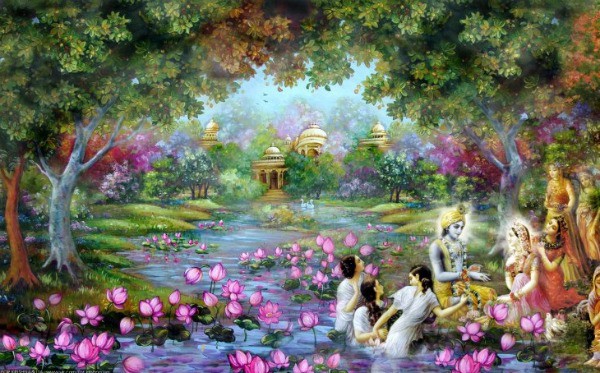
Above, Krishna and his gopis in the Vrindavan of myth and legend.
From there I go directly to Govinda’s Restaurant at the ISKCON Temple for breakfast. As it is an “ekadasi day” — a day without grains — I have a strange breakfast of fruit, juice, a mango lassi and kind of potato dosa. Then I have their thick herbal tea and a coconut laddu.
With money in my wallet and food in my tummy, I feel so much better about life and about the day. These things do matter, and I don’t agree with the spiritual people who turn their backs on embodied life.
In Vrindavan, I find myself thinking that if all the effort that goes into prayer, darshan, and parikrama were put into cleaning up the city, creating an irrigation system so more plants and trees can grow, installing proper plumbing, sterilizing the stray dogs, educating all the children, and addressing all the other social and environmental problems, than you would have a much more lovely, harmonious Vrindavan — the kind in myth and legend.
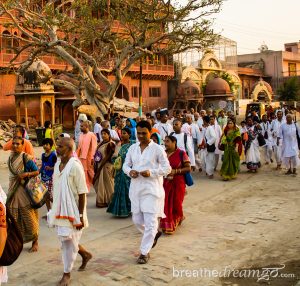
The ceasless Vrinadavan Parikrama passes Gopinath Bhavan
But in the meantime, it’s a very crowded, dirty, dusty place — no different to me than any other Indian town. I hail a bicycle rickshaw outside ISKCON and fall into the usual negotiations over the price. They say 100 rupees, which is two or three times the price that Indians pay. A young woman joins in and bargains one driver down to 50 rupees to take me to the Mirabai temple. He stops and buys two small bags of water from a street stall.
We ride through a long, narrow market area — it’s fascinating to see the stores, the old buildings, some carved, and the crazy traffic jams. Bullock carts, a camel cart, every type of vehicle, all vying for space in a very narrow street. We pass tiny children playing and open-air barbers and groups of devotees walking parikrama in their bare feet. Finally, we get there. Because of the distance and the heat, and the man’s advancing age, I decide to give him 100 rupees after all. He isn’t sure whether I mean for him to keep it. I feel his sweetness and humility in my heart, I feel humbled.
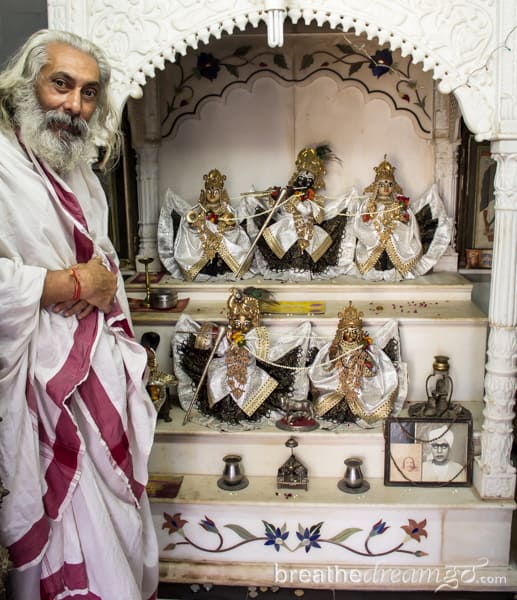
Praduman hands me a piece of 45-year-old paper
Immediately on stepping through the old, rusty gate, and entering the small residential temple, I feel cooler and calmer. I love the feeling in this shady, airy house, full of light and greenery, painted pale blue and white. The bearded man appears, this time in a more priestly garb, a white robe trimmed in red, and we sit down to talk.
He gives me a piece of paper, tells me it’s at least 45 years old, and that I should have it translated and copied. On it, he has carefully printed his name and address:
Praduman Pratapsingh,
Meerabai Temple
Govind Bagh, Vrindaban
Praduman tells me, in simple English, what’s written on the paper, which is in Hindi. He goes through the main details of Meerabai’s life, and how she was rejected by her husband’s family because of her devotion to Krishna, her dancing and singing. This is why she came to Vrindavan — to find peace and to devote her life to Krishna.
Praduman’s ancestor built this temple for her to live in, and she lived here for about 15 years. Apparently she wrote many poems in this temple. He continues to tell me her life story. Meerabai went from Vrindavan to Dwarka. While she was living in Dwarka, when she was about my age (around 50), there was a drought in Rajasthan. Some of her family members travelled to Dwarka to entreat Meerabai to return, but she refused. That night, according to Praduman, she dissolved in Lord Krishna — and the drought ended.
Praduman talks about Meerabai with conviction and enthusiasm, and though he must do this several times every day, he seems very passionate. He has an open face, large eyes, and he is very expressive. He is very accommodating to me, and shows me around the temple, poses for me and even opens the altar grate so I can photograph the statues. He tells me that he is the ninth generation of his family to be born here, and to maintain the temple. He has a son and daughter — they are the 10th generation (but his son is an artist and animator in Mumbai).
“People come here for peace, love and spiritual strength,” Praduman says. “This is the real place of Meerabai. She lives in this temple. People who come here can feel Meerabai and Gopal (Krishna) in their hearts.”
Though I am not a Krishna (Gopal) devotee, I do feel a light, happy atmosphere in this temple. It’s a great start to my Meerabai expedition to find this lovely temple and this warm and helpful man.
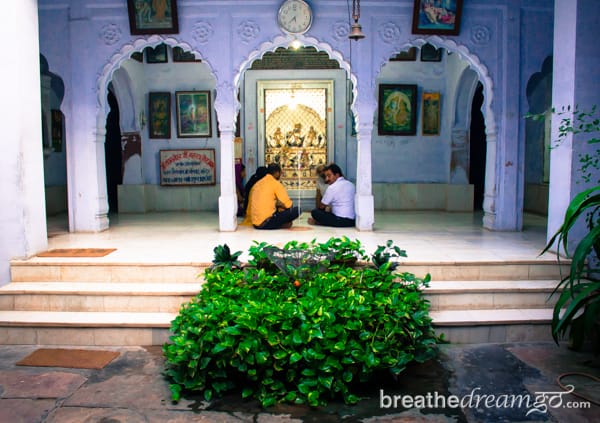
The interior of the Mirabai Temple in Vrindavan
Day 3: Moving on
I wake up on the third day of the Mirabai expedition feeling satisfied. Meeting Praduman and basking in the delightful energy of the Mirabai Temple is such a great start.
I’m also very grateful for the opportunity to stay at Gopinath Bhavan. It is a lovely red sandstone building, run by warm women, most of whom come from European countries such as France and Holland. They gave me a top floor room with a view of the Yamuna River, and the Parikrama parade. I slept very well on a simple bed, and had the luxury of an AC unit in my room.
Nevertheless, I find Vrindavan a difficult place. Very hot and dusty, menaced by grabby monkeys, stray dogs, wild pigs, cows and the natural substances they leave behind, and filled with auto drivers who try to extract maximum cash from foreigners as a matter of course.
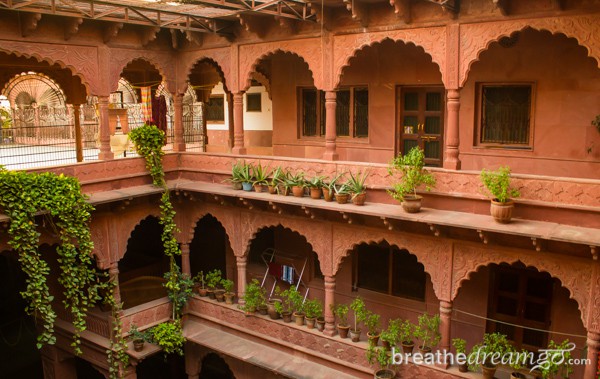
The lovely interior of Gopinath Bhavan, Vrindavan
Vrindavan in myth and legend is a fecund place of peace and harmony, a kind of garden-of-Eden where Krishna and his gopis (milk maids) cavorted in innocence, bathed in love. Vrindavan in reality cannot be further from this image. It must take enormous faith for the many devotees who flock here to feel the spiritual energy of this place.
I feel a bit bad about not feeling Krishna’s energy in Vrindavan. But when I was discussing the Mirabai expedition with a woman I met at Gopinath Bhavan, she said it’s great that I am giving attention to one of the female players in the Krishna story. So be it.
I am happy to move on.
I decide to leave early on my third day in Vrindavan. I have to be in Agra to take the train to Rajasthan at 5 p.m., so I make plans for a taxi to drive me there in the late morning. I consider seeing the Taj Mahal (for the third time), and decide to stop at the ITC Mughal hotel. I stayed here previously for a few days so it feels a bit like a homecoming.
I get a warm reception from Jyoti, the PR Director, who invites me for lunch with her in Peshawar, their signature restaurant. She offers me a room to get refreshed, and I swim in the pool, instead of seeing the Taj Mahal.

The ITC Mughal hotel in Agra captures the luxurious Mughal era design
The Mirabai expedition takes an unplanned detour into luxury and it feels right, too. Mirabai was a princess who lived in a sumptuous palace before striking out on her own, to both escape the cruelty of her husband’s family, and to follow the voice of her soul, the call of her devotion to Krishna. There is synchronicity in this visit too, as the ITC Mughal celebrates the era of Emperor Akbar — who visited Mirabai in disguise, and praised her talent and devotion, bestowing upon her a valuable necklace.
So, as Mirabai left her palace home, I have to leave the comfort of the ITC Mughal to brave the chaos of the Agra train station. Upon arriving by taxi, I try and negotiate a porter to carry my bags to the somewhat distant platform and help me find my berth, but the female (!) porter demand 350 rupees, probably three or four times the regular rate. Luckily, I never carry more luggage than I can handle in India, so I grab my bags and find my platform myself.
A broken heart, a spiritual journey

A pomegranate flower, ITC Mughal garden
The train is late, but eventually it arrives, I find my berth and settle in for the journey to Ajmer in Rajasthan. I’m in a lower berth, in the second-class compartment. Though it is not that clean, the bathrooms are a bit scary and I am surrounded by Indian men burping and snoring, somehow I like taking the train in India. I like the gentle movement and knowing I am going somewhere fascinating — plus I like it better than driving. The roads in India are a chaotic obstacle course and you really do feel you are taking your life in your hands.
Somehow, the movement of the train makes me philosophical. I started out on the Mirabai expedition with feelings of sadness and vulnerability. I didn’t like Vrindavan, I doubted my self and the expedition and I was missing my friends in Delhi.
I am wondering why am I travelling at all? Unlike Mirabai, I was not rejected and threatened by my family, though I did feel abandoned as a teenager after my parents divorced; and again after my parents died. But I still have my siblings and their families at home in Canada.
Heartache was one of the things that originally propelled my travels in India. Heartache also propelled my spiritual longing. But I think, perhaps, my heart is finally mending.
In Vrindavan, surrounded by bhaktis, I realized I want to live in the world. I don’t want to reject the embodied experience. I like a clean and aesthetically pleasing environment, a touch of luxury, some jewelry and makeup.
Some of the women devotees in Vrindavan seem to delight in dressing up in saris and looking pretty, reminding me of Krishna’s gopis; but others seem so thin and colourless, and I find myself concerned about them.
There must be a way to be spiritually aware and yet of this world. I would love to see spirituality and materialism come together, so that people increase their consciousness about daily life, about use of resources, garbage disposal, how we treat animals, the planet and each other; and also continue to enjoy the sensuality of life, and the aesthetics of art and nature.
I take out my iPad, to read The Great Railway Bazaar by Paul Theroux (perfect reading for a train journey in India). I’m on this train until I arrive in Ajmer at about 1:15 a.m. Though I have made careful plans, to have a reliable and reputable driver waiting for me on the train platform, it is always unnerving to arrive late at night at a train station in India.
NOTE: THE MIRABAI EXPEDITION is a cultural journey to follow in the footsteps of Mirabai, a 16th century poet and Krishna devotee. I undertook the expedition in October 2014 by travelling to all of the primary sites associated with her in India. It was made possible by an Explorer’s Grant from Kensington Tours, as part of the Explorers-in-Residence program.

Mariellen Ward is a freelance travel writer whose personal style is informed by a background in journalism, a dedication to yoga and a passion for sharing the beauty of India’s culture and wisdom with the world. She has traveled for about a year altogether in India and publishes an India travel blog, Breathedreamgo.com. Mariellen also writes for magazines and newspapers.








